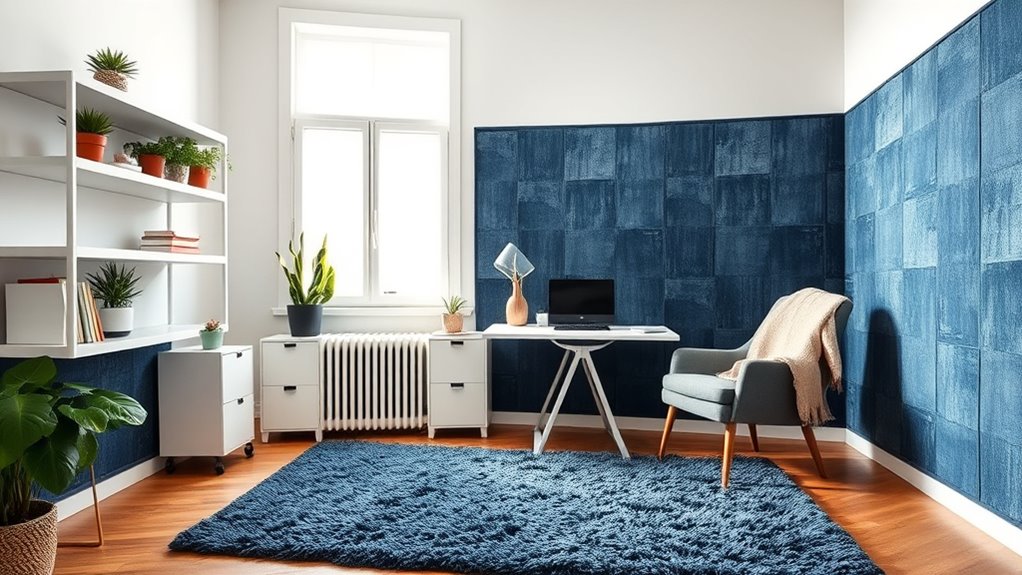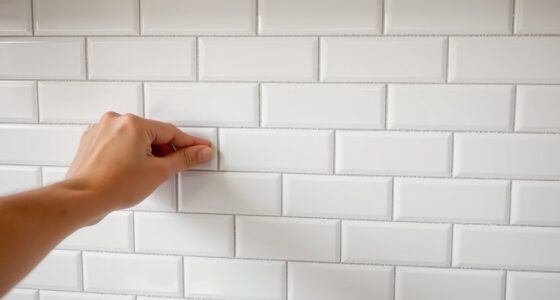To soundproof a room on a budget, start by sealing gaps around doors and windows with weatherstripping or caulk, and add draft stoppers to door bottoms. Use soft furnishings like thick rugs, curtains, and plush cushions to absorb sound. Install DIY acoustic panels or hang fabric hangings to reduce echo. Rearrange furniture to block noise paths and use inexpensive window covers. Keep exploring for more effective techniques to make your space quieter without spending a fortune.
Key Takeaways
- Seal gaps around windows, doors, and outlets with weatherstripping or caulk for immediate noise reduction.
- Use DIY soundproof curtains and window plugs made from thick fabrics or foam for budget-friendly noise blocking.
- Add soft furnishings like rugs, cushions, and hanging fabrics to absorb sound and minimize echoes.
- Install affordable acoustic panels or DIY fabric-covered foam panels on walls to dampen noise effectively.
- Rearrange furniture, placing soft or large pieces against shared walls to block and absorb sound transmission.
Sealing Gaps and Cracks for Immediate Noise Reduction
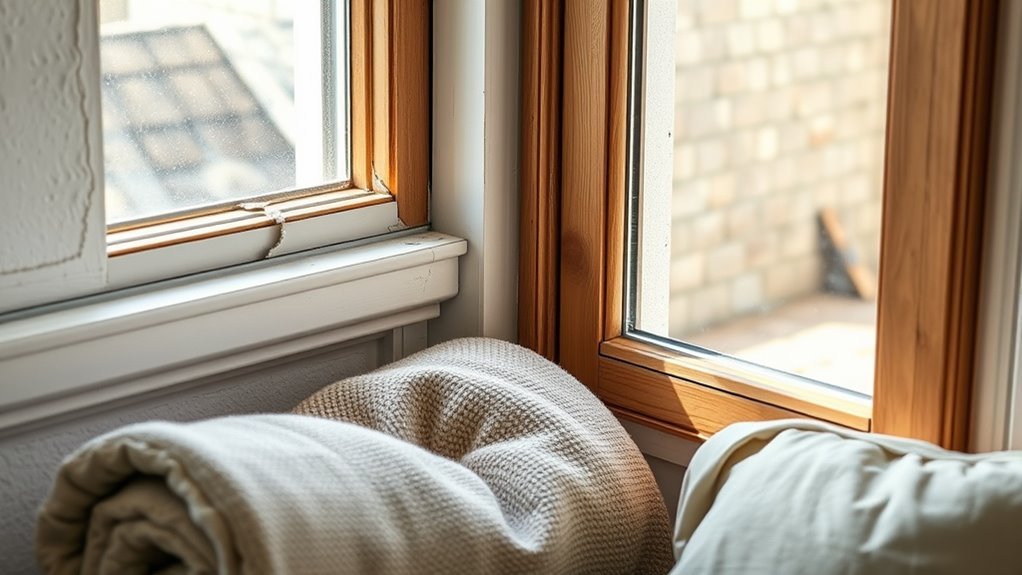
Sealing gaps and cracks is one of the quickest and most affordable ways to reduce noise in a room. Start by inspecting your door frames and adding door frame sealing strips to block sound leaks around doors. These inexpensive strips create a tight seal, preventing noise from escaping or entering. Next, look at your electrical outlets; installing simple outlet covers or foam gaskets can substantially cut down on sound transmission through these small openings. Don’t forget to check for gaps around windows, baseboards, and any other openings. Sealing these areas with affordable caulk or weatherstripping can make a noticeable difference. Taking these quick steps helps you improve your room’s acoustics instantly without breaking the bank. Additionally, understanding soundproofing techniques can guide you in making more effective modifications over time.
Using DIY Window Covers and Door Draft Stoppers
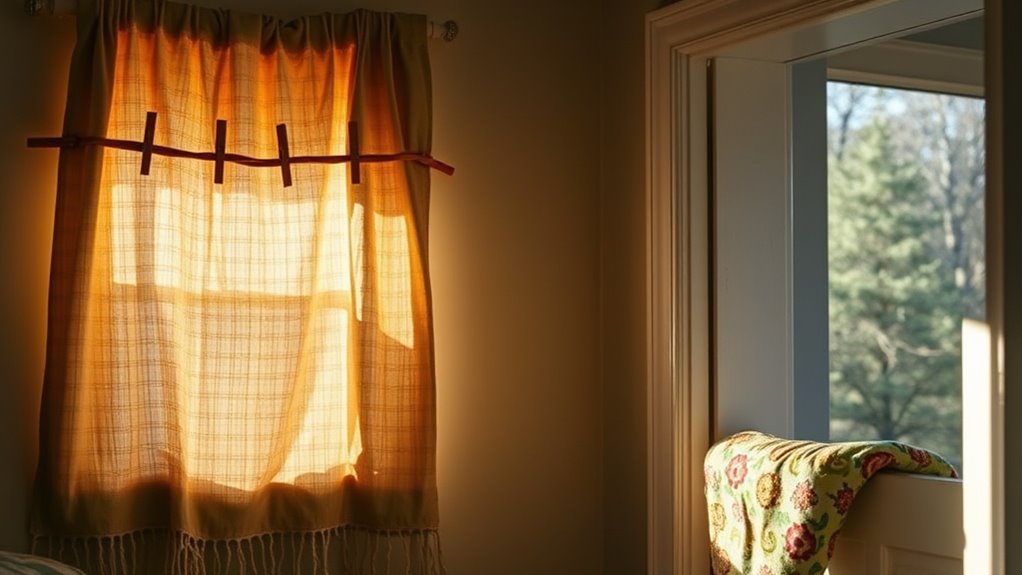
Have you considered creating DIY window covers and door draft stoppers to boost your room’s soundproofing? Soundproof curtains are a simple, affordable option that can block out noise effectively. You can make your own using thick fabrics like wool or heavy upholstery material, which absorb sound better than lightweight fabrics. For the door, DIY window plugs are a quick fix—stuff a sturdy material like foam or rolled-up towels into a plastic bag or wrap it in fabric to create a barrier that dampens sound leaks. These DIY solutions are easy to install and remove, making them perfect for temporary or budget-friendly soundproofing. Additionally, sound absorption techniques can further enhance noise reduction in your space. By combining soundproof curtains and DIY window plugs, you’ll notably reduce noise infiltration without breaking the bank.
Adding Soft Furnishings and Fabrics to Absorb Sound

Adding soft furnishings and fabrics to your room can considerably improve sound absorption and reduce noise reflections. These items help dampen sound waves, making your space quieter. Consider these options:
- Decorative wall hangings – Hang tapestries or fabric art to absorb sound and add visual appeal.
- Sound absorbing rugs – Place thick rugs on the floor to reduce echo and footstep noise.
- Soft furnishings – Use plush cushions, upholstered furniture, or fabric-covered storage to further absorb sound and create a cozy atmosphere.
- Incorporating layered textures throughout your room enhances the overall sound dampening effect and makes the space more inviting.
These additions are inexpensive, easy to install, and effective. By layering soft textures throughout your room, you’ll notice a significant reduction in noise and reflections, creating a more peaceful environment without breaking the bank.
Installing Inexpensive Acoustic Panels and Wall Treatments

Installing inexpensive acoustic panels and wall treatments is an effective way to enhance soundproofing without overspending. These panels use absorption materials that reduce echo and dampen noise, improving room acoustics. You can find affordable options online or at hardware stores, making it easy to upgrade your space. For a budget-friendly approach, try DIY panel installation—simply cut foam or fabric-covered panels to size and mount them with adhesive or hooks. Focus on areas where sound bounces most, like walls opposite noise sources or behind speakers. This simple addition creates a noticeable difference in sound quality while keeping costs low. With a little effort, you’ll enjoy a quieter, more comfortable environment without breaking the bank. Incorporating soundproofing techniques can further optimize your space for noise reduction.
Rearranging Furniture to Minimize Sound Transmission
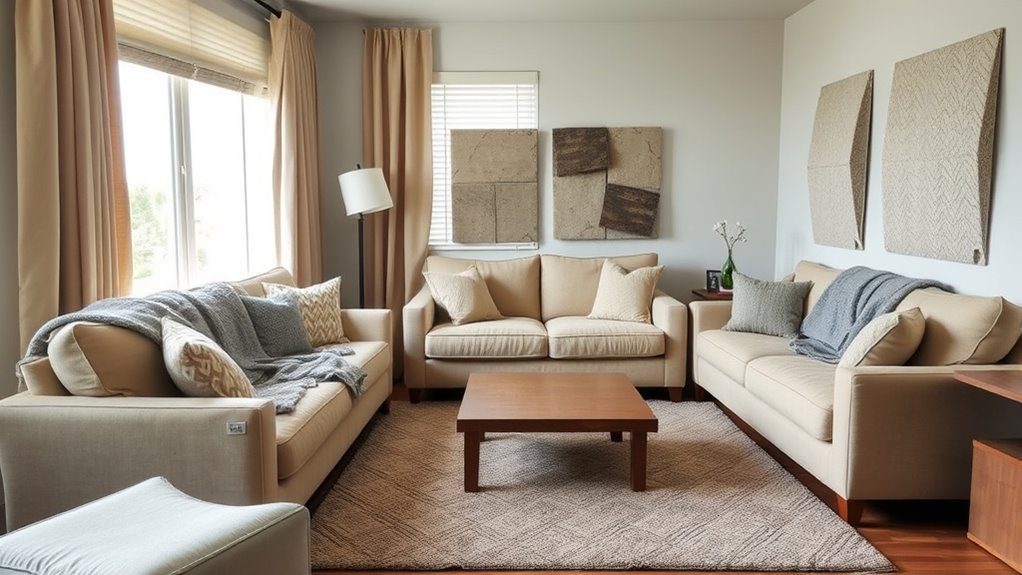
Rearranging your furniture can considerably reduce sound transmission between rooms or within a space. Proper furniture placement acts as a barrier, absorbing and deflecting sound waves. To maximize this effect, consider these strategies:
- Position large, soft furniture like couches or bookshelves against shared walls to block sound paths.
- Use soundproof curtains near windows and doorways to dampen noise leaks.
- Arrange furniture so that noisy sources, like TVs or speakers, are placed away from thin walls or open areas.
- Checking the retail hours of nearby stores can help you plan for quieter times to rearrange or work on soundproofing projects without disturbance.
Frequently Asked Questions
How Effective Are DIY Soundproofing Methods Compared to Professional Solutions?
When comparing DIY vs professional soundproofing, you’ll find that DIY methods can improve soundproofing effectiveness but often aren’t as thorough or durable as professional solutions. DIY projects are cost-effective and quick, yet they may not block all noise or handle high sound transmission. Professionals use specialized materials and techniques, ensuring better soundproofing, especially for demanding environments. So, your choice depends on your noise reduction needs and budget constraints.
Can Plants or Greenery Help in Reducing Room Noise Levels?
Plants and greenery can help reduce room noise levels by absorbing sound, dampening echoes, and creating a softer environment. Their benefits include improving air quality and adding visual appeal, while their impact on noise reduction is often underestimated. You’ll notice that plant benefits extend beyond aesthetics, as greenery impact can make a room feel calmer and quieter. While not as effective as soundproofing materials, plants offer a natural, budget-friendly noise solution.
What Are the Best Budget-Friendly Materials for Soundproofing Floors?
For budget-friendly soundproofing floors, you should explore various underlayment options like foam or cork, which are affordable and effective at absorbing noise. Carpet alternatives such as rugs, foam mats, or even thick blankets can also help reduce sound transmission. These options are easy to install, cost-effective, and make a noticeable difference in minimizing floor noise, giving you a quieter space without breaking the bank.
How Does Room Size Influence the Effectiveness of DIY Soundproofing?
Think of your room as a concert hall; its size shapes how sound waves behave. Larger rooms have more space for sound to bounce around, making DIY soundproofing less effective because the waves have more room to roam. Smaller rooms trap sound better, so your efforts will be more noticeable. Knowing your room dimensions helps you tailor your strategies, ensuring your DIY work makes the biggest impact.
Are There Any Quick Tricks to Block Noise From Neighboring Rooms?
To block noise from neighboring rooms quickly, start by sealing gaps around your door with weatherstripping or door seals to prevent sound leaks. Rearrange furniture, like placing bookshelves or large upholstered pieces against shared walls, to absorb sound. These simple tricks don’t require much time or money but can make a noticeable difference in reducing noise transfer and creating a quieter, more private space.
Conclusion
By sealing gaps, adding soft furnishings, and rearranging furniture, you’re weaving a tapestry of tranquility within your space. Each quick fix acts like a gentle shield, dampening noise and turning chaos into calm. With a little ingenuity and budget-friendly tricks, you transform your room into a peaceful haven—proof that serenity doesn’t have to come with a hefty price tag. Ultimately, you’re sculpting your sanctuary, where silence sings softly beneath your fingertips.
